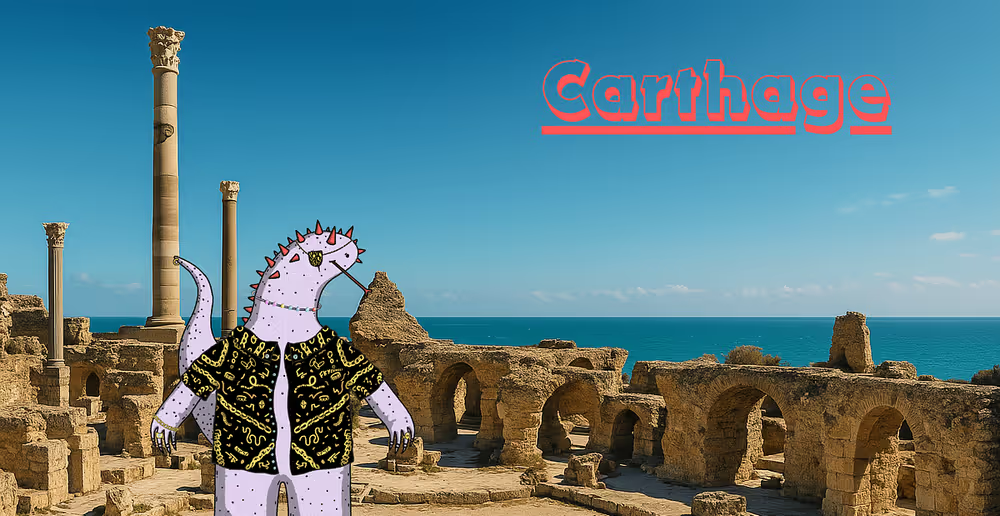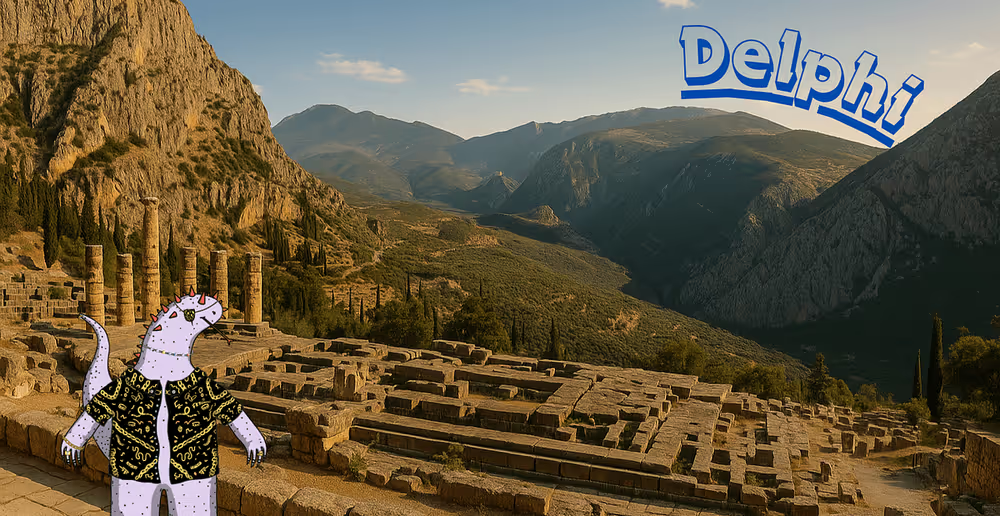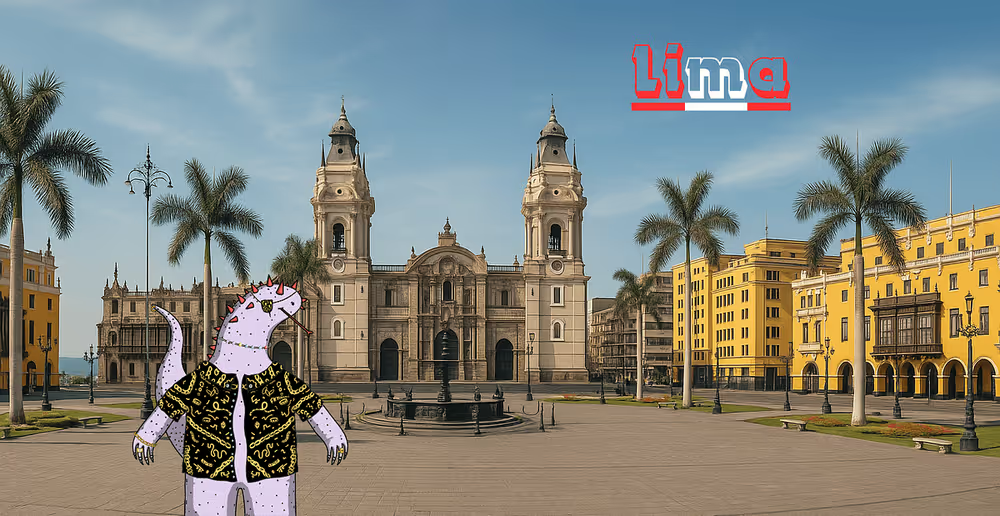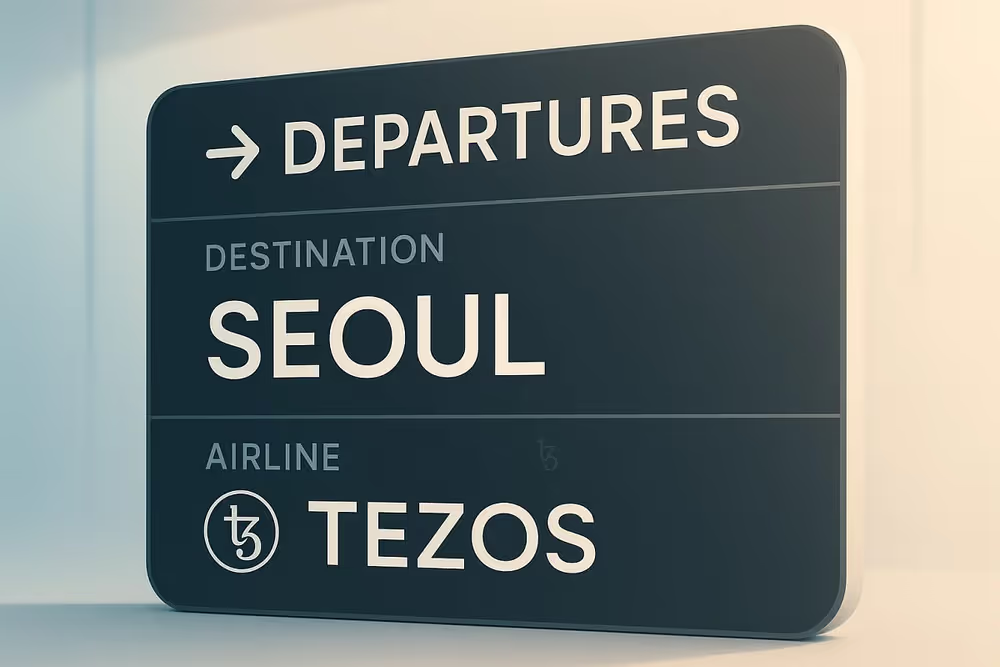Tezzard #1650's Grand Tour: 18 Cities That Built Tezos
From ancient wisdom to cutting-edge rollups, a travel diary of blockchain evolution.
11 minute read

Hi there, I’m Tezzard #1650. Ever since I was minted into existence, I’ve been endlessly curious about the universe I call home, a vast and evolving place known as Tezos. I wanted to understand how it grew from its early days into the dynamic network it is today. So, I packed my bags (and a few NFTs for the road) and began a journey to every city that’s played a role in shaping Tezos’ evolution.
Over the years, I’ve visited 18 destinations, from the ancient wisdom of Athens to the bustling energy of Rio, each one contributing something unique to the chain’s growth. Faster block times, smarter contracts, better staking, and innovations that pushed the limits of scalability, I’ve seen it all.
Now, I’m here to share my travel diary with you. These are the stops on my grand tour, what each city brought to Tezos, and maybe even a hint at where I’m heading next…
Athens — May 2019 #

My journey began in Athens, the site of Tezos’ very first protocol upgrade. The locals here once raised the gas limit per block and reduced the validator roll size from 10,000 tez to 8,000 tez, a change that made participation more accessible. It was here that I learned something important, this was the very first upgrade in Tezos history, proof that its on-chain governance could deliver real change.
Babylon — Oct 2019 #

The trail then led me to Babylon, where I learned about the arrival of Emmy+, a sturdier consensus algorithm that once helped the network run more smoothly. This upgrade also made smart contract development easier and refined the delegation process, allowing bakers and delegators to work together in greater harmony. I left feeling like Tezos had picked up a bit more ancient wisdom for the road ahead.
Carthage — Mar 2020 #

Next on the map was Carthage, where the locals had boosted gas limits per block and per operation, and fine-tuned the formula for baking and endorsing rewards. These changes improved both the capacity and fairness of the network. You could say Carthage made sure the chain had the fuel, and the math, for the long haul.
Delphi — Sep 2020 #

My route then took me to Delphi, a city known for efficiency. Here, the locals once improved gas costs and slashed storage costs by a factor of four, dramatically reducing fees for users and developers. It proved that smart optimizations could make Tezos not only faster, but far more affordable, a shift that would echo in upgrades to come.
Edo — Feb 2021 #

Next, I set my sights on Edo, where Tezos expanded its capabilities with Sapling and BLS12–381, unlocking privacy-preserving smart contracts. Tickets were introduced for native permissions, and the amendment process was updated, shortening periods to five cycles and adding a new adoption phase. Edo was proof that Tezos could upgrade anything through on-chain governance, even the on-chain governance process itself.
Florence — May 2021 #

Onward to Florence, a hub of creativity. The locals once doubled the maximum operation size, more than doubling smart contract capacity. Gas arithmetic sped up tenfold, depth-first execution made development more intuitive, and the unused test chain was retired for smoother governance. Florence showed that protocol upgrades could have both style and substance.
Granada — Aug 2021 #

The next stamp in my blockchain passport came from Granada, where Liquidity Baking made its debut. A small amount of tez was minted each block and paired with tzBTC in an AMM smart contract to build deep, decentralized liquidity. Popular contracts also became far more efficient, with gas consumption cut by three to six times. Granada was my first real glimpse of DeFi energy bubbling on Tezos.
Hangzhou — Dec 2021 #

Then I made my way to Hangzhou, where the groundwork for more advanced contracts was laid. The locals once added views, allowing contracts to read storage from other contracts, and timelock encryption to help prevent Block Producer Extractable Value. Caching sped up access to frequent data, and a global table of constants made building complex contracts easier. Hangzhou felt like the quiet hum of a network getting ready for bigger things.
Ithaca — Apr 2022 #

From Hangzhou, I traveled to Ithaca, a turning point in Tezos’ history. Here, the locals introduced Tenderbake, a new consensus algorithm that brought fast finality and better scalability. They reduced the amount of tez required to be a validator and reworked the baking and endorsement rewards for a smoother experience. Ithaca was when Tezos truly found its stride, and picked up the pace for the road ahead.
Jakarta — Jun 2022 #

My route then took me to Jakarta, where I learned about Tezos’ first experiment with enshrined rollups, Transaction Optimistic Rollups (TORUs). These boosted throughput, lowered fees, and opened the door to major long-term scalability. The locals also improved tickets and Sapling, enhancing privacy and decentralization. Jakarta felt like the first sketch of the Layer 2 roadmap that would later come to life.
Kathmandu — Sep 2022 #

Next, I arrived in Kathmandu to learn how Tezos had prepared for Smart Contract Optimistic Rollups (SCORUs). The locals had tested them on bleeding-edge networks, paving the way for their future debut. They also began pipelined block validation to speed things up, improved randomness with VDFs, and added event logging for contracts. Looking back, Kathmandu marked the moment right before a major leap in scalability.
Lima — Dec 2022 #

From Kathmandu, I traveled to Lima, where pipelining improvements separated validation from operation application, a move that would enable higher throughput. Consensus keys were introduced, giving bakers the flexibility to change their signing keys, and tickets ownership updates began appearing in transaction receipts, making life easier for indexers. Lima’s upgrades might have been behind-the-scenes, but they strengthened the network’s foundation for the road ahead.
Mumbai — Mar 2023 #

Next came Mumbai, a milestone in speed. Block times were cut in half to 15 seconds thanks to improved pipelining, and Smart Rollups were fully activated on mainnet, opening the door to huge throughput gains and decentralized WebAssembly applications. Tickets could now be transferred between user accounts, making them far more versatile. Mumbai was one of those historic upgrades where you can point and say, “That’s when things really started to accelerate.”
Nairobi — Jun 2023 #

From Mumbai, I traveled to Nairobi, remembered for its major boost in performance, up to eight times more transactions and smart contract calls per second, supported by an improved gas model for cryptographic signatures. Smart Rollups gained the ability to evolve alongside Layer 1 upgrades, and consensus improved with faster propagation of pre-attestations. Nairobi expanded the highway Tezos had been building for years.
Oxford — Feb 2024 #

After that, it was time for a visit to Oxford, where privacy took center stage with the introduction of Private Smart Rollups. Proof-of-Stake was refined, and timelocks were re-enabled for additional security options. In Oxford, I learned that even after big leaps in speed and scalability, Tezos could still innovate in security and privacy.
Paris — Jun 2024 #

Not too long ago, I arrived in Paris, where Tezos’ pace quickened again, block times dropped to 10 seconds, giving Layer 1 lower latency and faster finality. The Data-Availability Layer (DAL) went live on mainnet to boost Smart Rollups throughput. This was also the home of Adaptive Issuance, a redesigned Proof-of-Stake system that introduced a brand-new staker role, and Adaptive Slashing, an overhaul to network security and incentives. Paris was a turning point where performance, scalability, and staking economics all stepped up at once.
Quebec — Jan 2025 #

Quebec is still fresh in memory, the upgrade that pushed block times to 8 seconds with 16-second finality. The staking mechanism was refined further, and Adaptive Issuance fine-tuned for stronger economics. Quebec polished the machine Paris had built.
Rio — May 2025 #

And then there was Rio, my most recent stop, and the latest chapter in a long journey that began back in Athens. Here, staking became more flexible with 1-day network cycles, and 10% of participation rewards were directed to the DAL to help fuel Layer 2 scalability. Stricter inactivity thresholds for bakers strengthened the network’s resilience. Standing here, looking back at every upgrade along the way, I can see how each city’s contribution built on the last, turning Tezos into the fast, secure, and adaptable network it is today.

Eighteen stops, countless innovations, and a network transformed. From the roll size reductions of Athens to the flexible staking of Rio, each city added something unique to Tezos’ story. Looking back, each upgrade left its mark, one improving speed, another boosting scalability, others refining economics, all stacking together to turn Tezos from an ambitious idea into a fast, secure, and adaptable network.
But my map isn’t rolled up yet. There’s still more pins waiting to be placed with the next one being in a city called Seoul. The whispers are already out, native multisig accounts, aggregated attestations, and open unstake finalization are on the way. I’ve got my ticket ready, my bags packed, and my eyes on the horizon. Because if the last 18 stops have taught me anything, it’s that the best part of a Tezos journey… is always the next one.